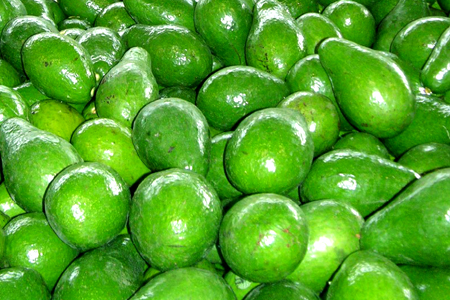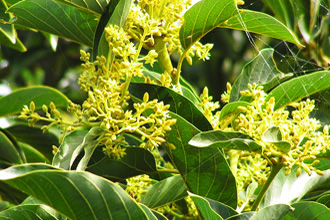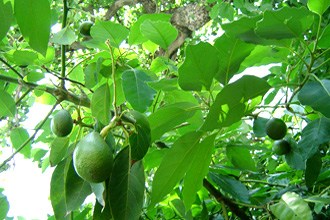_________________________________________
_________________________________________
|
Avocado
(Alligator Pear)
Persea americana |
 |
| Consumer Information |
Food Uses - Avocado
In North America, avocados are primarily served as salad vegetables, merely halved and garnished with seasonings, lime juice, lemon juice, vinegar, mayonnaise or other dressings. Often the halves are stuffed with shrimp, crab or other seafood. Avocado flesh may be sliced or diced and combined with tomatoes, cocumbers or other vegetables and served as a salad. The seasoned flesh is sometimes used as a sandwich filling. Avocado, cream cheese and pineapple juice may be blended as a creamy dressing for fruit salads.
Avocado slices have been pickled and marketed in glass jars. California began marketing frozen guacamole in 1951, and a frozen avocado whip, developed at the University of Miami, was launched in 1955. To help prevent enzymatic browning of these products, it is recommended that sodium bisulfite and/or ascorbic acid be mixed in before freezing.
Indians in tropical America break avocados in half, add salt and eat with tortillas and a cup of coffee—as a complete meal.
Mexican guacamole, a blend of the pureed flesh with lemon or lime juice, onion juice or powder, minced garlic, chili powder or Tabasco sauce, and salt and pepper has become a widely popular ";dip"; for crackers, potato chips or other snacks. The ingredients of guacamole may vary and some people add mayonnaise.
In Guatemalan restaurants, a ripe avocado is placed on the table when a hot dish is served and the diner scoops out the flesh and adds it just before eating. For a "gourmet" breakfast, avocado halves are warmed in an oven at low heat, then topped with scrambled eggs and anchovies.
In Brazil, the avocado is regarded more as a true fruit than as a vegetable and is used mostly mashed in sherbet, ice cream, or milk shakes. Avocado flesh is added to heated ice cream mixes (such as boiled custard) only after they have cooled. If mashed by hand, the fork must be a silver one to avoid discoloring the avocado. A New Zealand recipe for avocado ice cream is a blend of avocado, lemon juice, orange juice, grated orange rind, milk, cream, sugar and salt, frozen, beaten until creamy, and frozen again.
Some Oriental people in Hawaii also prefer the avocado sweetened with sugar and they combine it with fruits such as pineapple, orange, grapefruit, dates, or banana.
In Java, avocado flesh is thoroughly mixed with strong black coffee, sweetened and eaten as a dessert.
Because of its tannin content, the flesh becomes bitter if cooked. Diced avocado can be added to lemon-flavored gelatin after cooling and before it is set, and chunks of avocado may be added to hot foods such as soup, stew, chili or omelettes just before serving.
Have a raw avocado salad or cover some fresh avocado with lemon and sea salt for a nutritious snack.
Avocado Oil
Oil expressed from the flesh is rich in vitamins A, B, G and E. It has a digestibility coefficient of 93.8% but has remained too costly to be utilized extensively as salad oil. The amino acid content has been reported as: palmitic, 7.0; stearic, 1.0; oleic, 79.0; linoleic, 13.0.
The oil has excellent keeping quality. Samples kept in a laboratory in Los Angeles at 40ºF (4.4ºC) showed only slight rancidity after 12 years. There is much interest in the oil in Italy and France.
The Institut Francais de Recherches Fruitieres Outre Mer has studied the yield of oil in 25 cultivars. Joint Italian/Venezuelan studies of 5 prominent cultivars indicated that the fatty acid composition and tryglyceride structure was not influenced by variety.
The oil is used as hair-dressing and is employed in making facial creams, hand lotions and fine soap. It is said to filter out the tanning rays of the sun, is non-allergenic and is similar to lanolin in its penetrating and skinsoftening action. In Brazil, 30% of the avocado crop is processed for oil, 2\3 of which is utilized in soap, 1/3 in cosmetics. The pulp residue after oil extraction is usable as stockfeed.
|
_________________________________________
_________________________________________
|

|

|

|
| |
|
|
| International Scientific Research |
Vitamin & Mineral Medicine |
Optimal Health & Nutrition |
"The tamarind fruit pulp has been official in the British and American pharmacopoeias and most other international pharmacopoeias for its medicinal properties.
Some 200,000 lbs (90,000 kg) of the shelled fruits have been annually imported into the United States for the medicinal drug trade."
|
| Nutritional Information |
Health Benefits - Avocado
Brimming with the highest quality omega 3s, avocado is one of the most alkalizing foods available. Avocados are also very high in vitamin E, which is essential for glowing skin, shining hair and keeping wrinkles off your face.
Avocado halves average only 136 to 150 calories. The avocado has a high lipid content-from 5 to 25% depending on the cultivar. Among the saturated fatty acids, myristic level may be .1%, palmitic, 7.2, 14.1 or 22.1%; stearic, 0.2, 0.6 or 1.7%. Of the unsaturated fatty acids, palmitoleic may range from 5.5 to 11.0%; oleic may be 51.9, 70.7 or 80.97%, linoleic, 9.3, 11.2 or 14.3%. Non saponifiable represents 1.6 to 2.4%. Iodine number is 94.4.
Amino acids of the pulp (N = 16 p. 100) are recorded as: arginine, 3.4; cystine, 0: histidine, 1.8; isoleucine, 3.4; leucine, 5.5; lysine, 4.3;methionine, 2.1; phenylalanine, 3.5; threonine, 2.9; tryptophan, 0; tyrosine, 2.3; valine, 4.6; aspartic acid, 22.6; glutamic acid, 12.3; alanine, 6.0; glycine, 4.0; proline, 3.9; serine, 4.1.
Bone Health - Arthritis - Anti-Inflammatory - Avocado
The combined effect of the deluxe package of nutrients contained in avocados offers powerful anti-inflammatory benefits. Avocadoes' unique combination of Vitamins C and E, carotenoids, selenium, zinc, phytosterols and omega-3 fatty acids helps guard against inflammation. This means avocados can help prevent or mitigate against both osteo-arthritis and rheumatoid arthritis.
Diabetes - Cholesterol - Beneficial Fats - Avocado
Avocadoes provide the healthy kind of fat that your body needs. Like olive oil, avocadoes boost levels of HDL (the "good" cholesterol). HDL cholesterol can help protect against the damage caused by free radicals. This type of cholesterol also helps regulate triglyceride levels, preventing diabetes. A study published early this year in the Canadian Medical Association Journal found that a vegetarian diet, which includes HDL fats, can reduce levels of LDL (the "bad" cholesterol) as effectively as statin drugs.
Eye Health - Phytonutrients - Carotenoids - Avocado
Avocadoes are an excellent source of carotenoids. Although many people associate carotenoids only with red and orange produce, avocadoes are also an excellent source of this phytonutrient. Avocadoes, also known as alligator pears, offer a diverse range of carotenoids including not only the better known ones such as beta-carotene, alpha-carotene and lutein, but also lesser known varieties of this type of phytonutrient such as neoxanthin, zeaxanthin, chrysanthemaxanthin, neochrome, beta-cryptoxanthin and violaxanthin.
Every time you consume foods rich in carotenoids, you deliver high quality vitamin A to your body, thereby protecting eye health.
Heart Health - Cholesterol Levels - Avocado
In feeding experiments which excluded animal fat, 16 patients were given 1/2 to 1 l/2 avocados per day. Total serum cholesterol and phospholipid values in the blood began to fall in one week. Body weight did not increase. Cholesterol values did not rise and 8 patients showed decreases in total serum cholesterol and phospholipids.
Heart Health - Oleic Acid - Avocado
The fat content, which causes some uninformed health "experts" to deem avocadoes as unhealthy, actually provides protection against heart diseases. Studies have shown that oleic acid improves cardiovascular health. Oleic acid is the primary fatty acid in avocadoes. Many people now take supplements in order to consume more omega-3 fatty acids to lower their risk of heart disease. Avocadoes are rich in omega-3, delivering 160 milligrams per cup of alpha-linolenic acid.
Immune System Health - Carotenoids - Avocado
Carotenoids also enhance the functioning of the immune system and promote healthy functioning of the reproductive system. Since carotenoids are fat soluble, eating avocadoes optimizes the absorption of these nutrients.
Avocadoes provide all 18 essential amino acids necessary for the body to form a complete protein. Unlike the protein in steak, which is difficult for most people to digest, avocado protein is readily absorbed by the body because avocadoes also contain fiber. If you are trying to cut down on animal sources of protein in your diet, or if you are a vegetarian, vegan or raw foodist seeking more protein, avocadoes are a great nutritional ally to include not merely as an occasional treat, but as a regular part of your diet.
Source: http://www.naturalnews.com/034370_avocado_nutrition_facts_health.html#ixzz29krjPRcu
Learn more: http://nutrionomics.com/
|
_________________________________________
|
Anti-Oxidants - Super Foods - Research
Two important messages are emerging from anti-oxidant research:
1. First, that the health benefits of these phytochemicals are derived from whole foods ... and not from supplements.
2. Second, that "the synergistic effect is powerful" - in other words, antioxidant activity isn't the function of a single vitamin or nutrient alone,
... "it is the combination of countless compounds in a fruit working together."
Source: www.eatingwell.com - Alison Cleary
|
_________________________________________
|
| "Let food be thy medicine ... and medicine be thy food" - Hippocrates |
_________________________________________
|
"The tamarind fruit pulp has been official in the British and American pharmacopoeias and most other international pharmacopoeias for its medicinal properties.
Some 200,000 lbs (90,000 kg) of the shelled fruits have been annually imported into the United States for the medicinal drug trade."
|
_________________________________________
|
"The Bait and Switch" ... How Big Pharma Repackages Vitamins as Expensive Drugs !!!
The latest prescription medicine called Niaspan, which targeted to men and women with coronary artery disease and high cholesterol:
“...works to raise HDL (good) cholesterol levels in people with abnormal cholesterol levels ... also works to lower LDL (bad) cholesterol and triglycerides.”
Plus, Niaspan can "reduce the risk of another heart attack in people who have high cholesterol and a history of heart attacks."
Now, here's the thing about Niaspan... it isn't really a drug! ... it's nothing more than time-released niacin (vitamin B3)!
You can get a month's supply (without a doctor's order) from most vitamin shops for under $7. Without a doubt, you're much better off going that route... because Abbott Labs will charge you a heck of a lot more ... this profitable hoax, earning hundreds of millions of dollars for the drug giant Abbott Labs!
Source: Dr. Allan Spreen - Nationally acclaimed as America’s “Nutrition Physician” - www.healthiertalk.com
|
_________________________________________
|
"The Bait and Switch" ... How Big Pharma Repackages Fish Oil as Expensive Drugs !!!
You've probably heard of a prescription drug called Lovaza, right? I chuckled when I first heard about it, because it's nothing more than refined fish oil.
But it sounds snazzy and you need a doctor's prescription for it ... so it must work better than regular fish oil, right?
Wrong. It doesn't. It contains the same active ingredients you find in fish oil: EPA and DHA.
But Big Pharma managed to fool many, many Americans with this hoax.
In fact, this kind of con is hugely profitable for Big Pharma ... earning billions of dollars for the drug giant Abbott Labs.
For this reason alone, we will see more and more vitamins magically "repackaged" and sold as drugs.
Source: Dr. Allan Spreen - Nationally acclaimed as America’s “Nutrition Physician” - www.healthiertalk.com
|
_________________________________________
|
Read more International Scientific Studies and Nutritional Medical Research at "Nutrionomics ... the Science of Nutrition" (www.nutrionomics.com)
|
_________________________________________
_________________________________________
|

|
 |
 |
| |
|
|
| Avocado - Fruit |
Avocado - Blossom |
Avocado - Tree |
| Fruit Grower - Information |
TMF Florida Fruits
Southern Florida has long been the site of tropical and subtropical fruit production and research. Specialty tropical fruits have been part of the Florida tropical fruits research program at the TREC - Tropical Research and Educational Center - (www.trec.ifas.ufl.edu) since its establishment in 1930.
The future of tropical fruits in South Florida seems very bright, especially considering the involvement and investment of local growers in the important research efforts. The 1980's saw a major increase in the areas planted to specialty tropical fruits in southern Florida.
A wealth of International scientific and medical research (www.nutrionomics.com) supports the medical and nutritional health benefits of tropical and subtropical fruits, high in bio-natural vitamins, minerals, enzymes and other vital nutrients. Exemplary marketing campaigns supported by proven scientific research have accompanied increases in fruit production and should serve as a model for other industries and societies.
For the consumers... the immediate goal of TMF Florida is to promote the campaign for healthy living and support the finally emerging "Green Wave" in Nutrition, to help the end consumer to better understand the cardinal importance of their daily nutritional decisions, and to experience the significance of optimal bio-natural nutrition upon their health and lifestyle.
For the Florida fruit grower... TMF Florida represents the show window for their wonderful fruits and the marketing strategy so deeply ignored in the past - based on all the internet possibilities available today and certainly increasing exponentially in the future.
|
_________________________________________
_________________________________________
|

Copyright @ 2012 www.TMFflorida.com. www.TropicalMedicalFruits.com. All rights reserved.
|
|